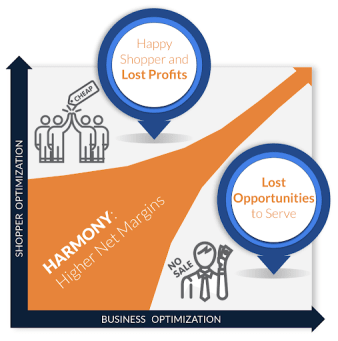The hype around “personalization” has been growing steadily in the market, prompting increased investment as a result.
However, many are not seeing the dramatic returns that they originally anticipated – there is no business value to be found.
Everything is not as it seems
In 2019, 74% of businesses said they were looking to maintain or increase their investment in personalization technology. This was expressed despite 51% of those businesses also reporting that the implementation of such technology had fallen below their expectations. There is a clear disconnect between the drive to invest more and success in the outcomes that result, leading to businesses pumping more and more resources into technology that will ultimately fail them.
Personalization technology itself isn’t the problem here. Instead, the problem lies in the approach commerce teams are taking when making investments in its name. Personalization has value, but a proper strategy is needed in order to meaningfully tap into its capabilities.
The source of the problem
A value chain model reveals that there are many different components in an organization that are essential to its functionality. Marketing, sales, manufacturing, and distribution are a few of many.
This means there is a large collection of individuals performing a wide range of activities, each with their own motivations and objectives. In being so hyperfocused on their own goals, business groups tend to overlook those of others or assume they are mutually exclusive with their own. This zero-sum mentality then leads them to pursue different technological solutions in order to address those goals. It is this siloed approach that is the primary cause of poor personalization investments.
The most problematic part of this phenomenon? Commerce teams don’t even realize it’s happening.
The case of shopper optimization and business optimization makes a great example. In a perfect world for a customer, they would be able to find the exact product they wanted for free. For a business, the dream scenario would be selling a product at multiple times its true value. Neither situation is realistic, but it does reveal two different ideals involving focal points seemingly at odds with each other: customer satisfaction and business outcomes.

I say seemingly because they’re actually not – or rather, they don’t have to be. While the extremes may remain incompatible, a balance between customer satisfaction and business outcomes, such as profitability, is indeed possible. However, bringing it about requires a new vision and technology that takes everything into consideration.
A new way with AI
Let’s call this new way of thinking “the value chain approach”.
This view dictates that it is necessary to collect and leverage insights across the value chain, so that the needs and objectives at every point are in view. Doing so helps to develop a holistic understanding of what both customers and the business need. With this understanding in place, it then becomes possible to address each group in a way that makes them both happy.
Customers get what they need, at a price point that allows your business to succeed. But how can you do this when every customer has very different needs? Artificial Intelligence.

AI is what allows you to scale this approach. With AI comes the ability to draw together customer and business signals from disparate silos to consider both simultaneously. With this holistic view it becomes possible to formulate actionable insights geared toward striking an optimal balance between all objectives. This makes it so that when important organizational decisions are made, everyone’s needs are taken into account, resulting in optimization at each step of the value chain.
For example, think about a customer buying a brown hat online. There may be a number of hats that all look nearly identical, but one in particular has a greater profit margin.
AI can take those signals from different areas of your business into account along with customer preferences and act upon them by ensuring that specific hat is seen first. It will still satisfy the customer’s needs, while boosting the value of the conversion to your entire business.
Let’s break it down.
Breaking down business value at each step of the value chain

1.) Lowering Merchandising costs:
Creating promotions to move inventory and creating rules to make sure customers find what they’re looking for takes a lot of time and money.
By providing the most relevant insights to merchandisers, holistic AI technologies significantly reduce the time they spend on non-value added tasks, reducing the overall merchandising cost.
Additionally, these insights help formulate optimal merchandising practices, fostering a deeper understanding of users’ behavior, which translates to a more relevant shopping experience and an uplift in sales.
2.) Lowering Supply chain management costs:
Inventory management systems are typically not feeding live insights to commerce platforms. This leads to an increase in the carrying cost of certain products (i.e. handling expenses, warehouse overhead inventory control, insurances etc.), which negatively impacts the company’s margin.
Holistic AI technology applied across the value chain feeds the most relevant information to the commerce site in a dynamic fashion. As a result, both profit margin and customer preferences are taken into account to determine which items should be prioritized for recommendation.
3.) Increasing revenue from On-site Experience:
This part of the value chain is where personalization engines have an impact. They learn from customer interaction to create profiles and personas, and recommend relevant products/services for visitors coming to the site – but this is not enough.
Personalized onsite experiences cannot just be a function of customer needs – business objectives from across the value chain also need to be factored into the personalization equation. Practically applied AI does that for you, instantly, boosting your revenue as a result.
4.) Lowering Support costs:
Organizational silos often mean that sales and support don’t speak. This sets a major problem in motion – products that start to demand more support do not necessarily stop being recommended and sold automatically on commerce websites.
Only with the power of AI is it possible to evaluate the impact that increased support costs are having on the product margin in real time and automatically demote defective products from the commerce site. While avoiding the creation of additional support costs, AI simultaneously delivers recommendations for higher-margin products that are better aligned with customers’ needs and preferences.
Leveraging personalization technology alone is not enough. A holistic view of the value chain must be taken into account as well in order for personalization investments to provide tangible business value across the company’s value chain.
Bringing it all together: Experience Intelligence Platforms
The bottom line is that you don’t always need multiple solutions to address multiple pain points. Beyond being ineffective, disconnected investments actually leave your organization worse off than if no initiative had been taken at all.
What’s really needed is a platform that will deliver personalized experiences for your customers while also delivering on business goals. An Experience Intelligence Platform does just that, but it’s essential to do due diligence before making the decision to invest. Investing in technology like this requires not only knowing the capabilities it should have, but having proof that it can actually deliver them.
Now that you know how to break down the value chain and assess the business value of AI at every stage, take this new knowledge into conversations with potential personalization solution vendors. Demand to see if value is truly delivered – for everyone in your organization.


